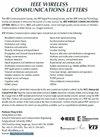ODE-Former for Mobile Channel Prediction: A Novel Learning Structure Leveraging the Physics Continuity
IF 5.5
3区 计算机科学
Q1 COMPUTER SCIENCE, INFORMATION SYSTEMS
引用次数: 0
Abstract
Obtaining accurate channel state information (CSI) is crucial and challenging for multiple-input multiple-output (MIMO) wireless communication systems. With the increasing antenna scale and user mobility, traditional channel estimation approaches suffer greatly from high signaling overhead and channel aging problems. By exploring the intrinsic correlation among a set of historical CSI instances, channel prediction is proven to increase the CSI accuracy while lowering the signaling overhead significantly. Existing works view this problem as a regular discrete sequence prediction task while ignoring the unique physics property of wireless channels. This letter proposes a novel former-like learning structure based on neural ordinary differential equations (NODEs) inclusively designed for accurate and flexible channel prediction. The proposed network aims to represent wireless channels’ implicit physics spatial-temporal continuity by integrating the Neural ODE into a former-like learning structure. Our proposed method impeccably fits channel matrices’ mathematics features and enjoys solid network interpretability. Experimental results show that the proposed learning approach outperforms existing methods from the perspective of accuracy, flexibility, and robustness.用于移动信道预测的ODE-Former:一种利用物理连续性的新型学习结构
获取准确的信道状态信息是多输入多输出(MIMO)无线通信系统的关键和挑战。随着天线规模的扩大和用户移动性的提高,传统的信道估计方法存在较高的信令开销和信道老化问题。通过探索一组历史CSI实例之间的内在相关性,信道预测被证明可以提高CSI的准确性,同时显著降低信令开销。现有的研究将此问题视为一个常规的离散序列预测任务,而忽略了无线信道独特的物理特性。这封信提出了一种新颖的基于神经常微分方程(节点)的类前学习结构,包括精确和灵活的信道预测。所提出的网络旨在通过将Neural ODE集成到类前学习结构中来表示无线信道的隐式物理时空连续性。我们提出的方法完美地符合通道矩阵的数学特征,并具有良好的网络可解释性。实验结果表明,所提出的学习方法在准确性、灵活性和鲁棒性方面都优于现有的学习方法。
本文章由计算机程序翻译,如有差异,请以英文原文为准。
求助全文
约1分钟内获得全文
求助全文
来源期刊

IEEE Wireless Communications Letters
Engineering-Electrical and Electronic Engineering
CiteScore
12.30
自引率
6.30%
发文量
481
期刊介绍:
IEEE Wireless Communications Letters publishes short papers in a rapid publication cycle on advances in the state-of-the-art of wireless communications. Both theoretical contributions (including new techniques, concepts, and analyses) and practical contributions (including system experiments and prototypes, and new applications) are encouraged. This journal focuses on the physical layer and the link layer of wireless communication systems.
 求助内容:
求助内容: 应助结果提醒方式:
应助结果提醒方式:


